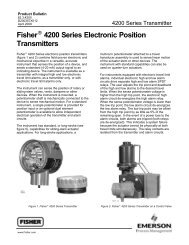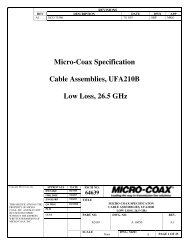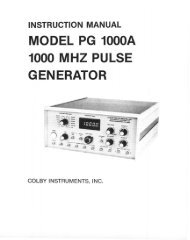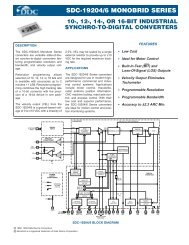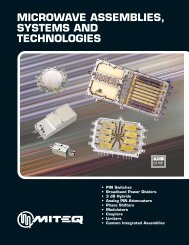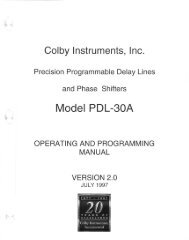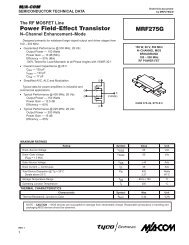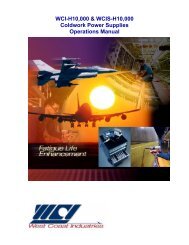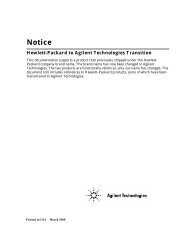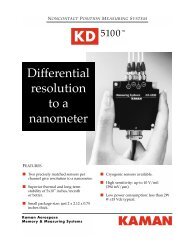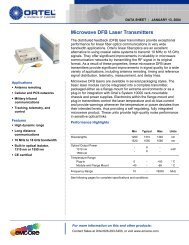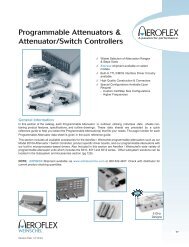Split Mandrel Tooling Manual.p65 - ColdWork - West Coast Industries
Split Mandrel Tooling Manual.p65 - ColdWork - West Coast Industries
Split Mandrel Tooling Manual.p65 - ColdWork - West Coast Industries
You also want an ePaper? Increase the reach of your titles
YUMPU automatically turns print PDFs into web optimized ePapers that Google loves.
<strong>Split</strong> <strong>Mandrel</strong> Puller<br />
<strong>Tooling</strong> <strong>Manual</strong><br />
OM-SM-9302-3<br />
Seattle, Washington
Coldwork <strong>Tooling</strong> <strong>Manual</strong><br />
Table of Contents<br />
Section 1—Introduction<br />
1.1 Introduction .................................................................................... 1<br />
1.2 Typical Applications ....................................................................... 2<br />
Section 2—Coldwork Procedure<br />
2.1 Introduction .................................................................................... 3<br />
2.2 Assembling <strong>Tooling</strong> ........................................................................ 3<br />
2.3 Hole Preparation ............................................................................ 5<br />
2.4 Coldwork the Hole .......................................................................... 6<br />
2.5 Final Steps ..................................................................................... 6<br />
Section 3—Puller Gun<br />
3.1 Introduction .................................................................................... 7<br />
3.2 Theory of Operation ....................................................................... 7<br />
3.3 Disassembly ................................................................................ 11<br />
3.4 Assembly ..................................................................................... 12<br />
3.5 Broken or Stuck <strong>Mandrel</strong>.............................................................. 14<br />
Section 4—Extension Nosecap<br />
4.1 Introduction .................................................................................. 16<br />
4.2 Nosecap Removal and Assembly–Standard & Quick Change ..... 16<br />
Section 5–Troubleshooting 18<br />
Section 6–Appendix -<br />
6.1 Retrofitting a Boelube Pump ........................................................ 22<br />
6.2 Schematic .................................................................................... 23<br />
6.3 Parts List ...................................................................................... 24
<strong>Split</strong> <strong>Mandrel</strong> Pullers <strong>Tooling</strong> <strong>Manual</strong> 1<br />
Section 1—Introduction<br />
1.1 Introduction<br />
The <strong>West</strong> <strong>Coast</strong> <strong>Industries</strong>, Inc. hydraulically powered, pnuematically controlled, puller guns are used to pull<br />
a tapered mandrel through the workpiece in the coldworking process. The Model 300 is used to coldwork<br />
hole diameters up to 27 /64" (12-3-N), while the Model 400 will coldwork holes between 3 /8" (12-0) and 43 /64" (20-<br />
3); both offer a maximum material stackup of 3½ inches in aluminum.<br />
While it is normally recommended our customers return the units to WCI for maintenance and repair, this<br />
manual is provided for those customers having tool repair facilities and trained technicians available to<br />
perform these types of repairs. It is important to note, due to the high hydraulic pressures developed by the<br />
unit, any repair or service must be in strict accordance to the steps outlined in this manual.<br />
OM-SM-9302-3<br />
14900 Whitman Avenue North Tel: (206) 365-7513<br />
Seattle, Washington 98133 Fax: (206) 365-7483
<strong>Split</strong> <strong>Mandrel</strong> Pullers <strong>Tooling</strong> <strong>Manual</strong> 2<br />
1.2 Typical Applications<br />
Refer to Figure 1-01. A standard nosecap may be used for most applications of coldworking. For restricted<br />
access situations wherein lateral access problems exist, it may be necessary to utilize a nose extension on<br />
a standard puller gun.<br />
WCI-300-20<br />
Standard Nosecap<br />
No Restricted Access<br />
Problem<br />
Solution<br />
WCI-300-20<br />
WCI-300-20<br />
Extension Nosecap<br />
Restricted Lateral Clearance<br />
Figure 1-01<br />
OM-SM-9302-3<br />
14900 Whitman Avenue North Tel: (206) 365-7513<br />
Seattle, Washington 98133 Fax: (206) 365-7483
<strong>Split</strong> <strong>Mandrel</strong> Pullers <strong>Tooling</strong> <strong>Manual</strong> 3<br />
Section 2—Coldworking Procedures<br />
2.1 <strong>Tooling</strong> Selection<br />
2.1.1 Select the proper puller unit, mandrel, pilot and<br />
nosepiece for the hole size to be processed.<br />
2.1.2 Refer to Figure 2-01 for an overview of the coldworking<br />
process.<br />
2.1.3 Check mandrel wear by inserting the inspection<br />
pin in the hollow mandrel (this takes the place of<br />
the internal pilot). Check mandrel with no-go<br />
mandrel wear gage.<br />
2.1.4 Check pilot wear utilizing the pilot wear gage. If<br />
the pilot goes through the wear gage slot, the pilot<br />
is worn and must be replaced.<br />
2.2 Assemble <strong>Tooling</strong><br />
WARNING<br />
Do not remove any part of the puller unit<br />
while it is connected to the power pak or<br />
supply air source. Failure to comply may<br />
cause serious injury.<br />
2.2.1 Removal of Nosecap and Barrel<br />
Refer to Figure 2-02.<br />
2.2.1.1 Remove the nosecap by loosening three<br />
set screws around its circumference.<br />
1. Drill start hole with start drill<br />
2. Ream hole to proper starting size with start reamer<br />
3. Verify start hole size with hole gage<br />
4. Inspect mandrel by inserting<br />
inspection pin in end of<br />
mandrel and checking mandrel<br />
with the mandrel wear gage<br />
5. Start pass thru of hole. <strong>Split</strong><br />
mandrel collapses<br />
6. Pass-thru is complete.<br />
Nosecap is flush to material.<br />
Extend Pilot thru center of<br />
mandrel.<br />
7. Start coldworking. The hole<br />
diameter expands as the now<br />
solidified mandrel is drawn<br />
back through the material<br />
8. Coldworking complete.<br />
<strong>Mandrel</strong> will return to ready<br />
position<br />
9. Inspect coldworked hole with hole gage.<br />
10. Ream hole to final hole size with piloted reamer<br />
11. Inspect final reamed hole with hole gage. Countersink if necessary<br />
Figure 2-01<br />
OM-SM-9302-3<br />
14900 Whitman Avenue North Tel: (206) 365-7513<br />
Seattle, Washington 98133 Fax: (206) 365-7483
<strong>Split</strong> <strong>Mandrel</strong> Pullers <strong>Tooling</strong> <strong>Manual</strong> 4<br />
Nosecap<br />
Set Screw<br />
Groove<br />
Lubrication Line<br />
Set Screws<br />
Set Screw<br />
Endcap<br />
WCI-300-20<br />
Barrel<br />
<strong>Mandrel</strong><br />
Pilot<br />
Threaded<br />
Adapter<br />
Puller<br />
Figure 2-02<br />
Inner (pilot)<br />
Outer (interlock)<br />
WCI-300-20<br />
Pilot Wrench<br />
Pilot<br />
Figure 2-03<br />
2.2.1.2 Remove the acorn nut on the lubrication<br />
line. Pull lubrication line from fitting on<br />
nosecap.<br />
2.2.1.3 Slide the nosecap from the mandrel and<br />
barrel.<br />
2.2.1.4 Remove the barrel from the puller unit by<br />
loosening the set screw located on the<br />
housing. Remove the barrel exposing<br />
the threaded adapter.<br />
2.2.1.5 Loosen the set screw in the threaded<br />
adapter and remove the mandrel by<br />
unthreading it from the threaded adapter.<br />
2.2.2 Pilot Removal<br />
2.2.2.1 Use the appropriate pilot wrench set to<br />
remove the pilot from the puller unit (ref<br />
fig 2-03).<br />
2.2.2.2 Insert the wrench set into the threaded<br />
adapter until the inner wrench is seated<br />
on the hex portion of the pilot. Rotate the<br />
knurled knob of the inner wrench from<br />
side to side while at the same time<br />
pressing lightly against the wrench. This<br />
insures the wrench is seated on the hex<br />
of the pilot.<br />
OM-SM-9302-3<br />
14900 Whitman Avenue North Tel: (206) 365-7513<br />
Seattle, Washington 98133 Fax: (206) 365-7483
<strong>Split</strong> <strong>Mandrel</strong> Pullers <strong>Tooling</strong> <strong>Manual</strong> 5<br />
2.2.2.3 Slide the outer wrench into the threaded<br />
adapter until it is seated on the hex<br />
portion of the safety interlock. Rotate the<br />
knurled knob of the outer wrench from<br />
side to side while at the same time pressing<br />
lightly against the wrench. This insures<br />
the wrench is seated on the hex of<br />
the safety interlock.<br />
2.2.2.4 While holding the outer wrench, turn the<br />
inner wrench counterclockwise until the<br />
pilot is free from the safety interlock.<br />
2.2.2.5 Remove both wrenches with the pilot.<br />
2.2.3 Pilot Installation<br />
2.2.3.1 To install the pilot, insert the long rod end<br />
of the pilot into the inner wrench until the<br />
hex is seated (the threaded end of the<br />
pilot should be sticking out from the<br />
wrench).<br />
2.2.3.2 Insert the inner wrench into the outer<br />
wrench.<br />
2.2.3.3 Insert this entire assembly into the<br />
threaded adapter.<br />
2.2.3.4 Slide the outer wrench into the threaded<br />
adapter until it is seated on the hex of the<br />
safety interlock. Rotate the knurled knob<br />
of the outer wrench from side to side<br />
while at the same time pressing lightly<br />
against the wrench. This insures the<br />
wrench is seated on the hex of the safety<br />
interlock.<br />
2.2.3.5 While holding the outer wrench, turn the<br />
inner wrench (clockwise) until the pilot is<br />
seated into the safety interlock. Do not<br />
overtighten. Finger tight is sufficient.<br />
2.2.3.6 Remove the two wrenches from the<br />
threaded adapter. Insure the safety interlock<br />
is seated against the valve in the<br />
end cap by pushing the pilot toward the<br />
end cap.<br />
2.2.4 Thread the corresponding mandrel into the<br />
threaded adapter until it is seated. Tighten the set<br />
screw on the threaded adapter to hold the mandrel<br />
in place.<br />
2.2.5 Installation of Barrel and Nosecap<br />
2.2.5.1 Re-install the barrel onto the puller unit.<br />
Tighten the set screw on the housing<br />
when the barrel is seated.<br />
2.2.5.2 Slide the corresponding nosecap onto<br />
the mandrel until it is seated on the<br />
barrel. Position the nosecap by turning to<br />
the desired position. Tighten the three<br />
(3) set screws to hold it in place.<br />
2.2.5.3 Re-install the lubrication line into the<br />
fitting on the nosecap. Tighten the acorn<br />
nut. Do not overtighten. Finger tight, then<br />
1<br />
/4 turn with a wrench is sufficient.<br />
2.2.6 Final Setup<br />
2.2.6.1 Connect the puller unit to the power unit<br />
via the quick connect fittings on the hose<br />
assembly.<br />
2.2.6.2 Connect an air supply line to the power<br />
unit.<br />
2.2.6.3 Cycle the puller unit by depressing the<br />
trigger.<br />
2.2.6.4 The pilot will extend, the power unit will<br />
activate causing the mandrel to retract.<br />
2.2.6.5 Releasing the trigger will stop the power<br />
unit when the mandrel has completely<br />
retracted.<br />
2.2.6.6 The lubrication line may have lost an<br />
amount of lubricant. To replenish this<br />
supply, the puller hose assembly must<br />
be connected to the power unit. Press<br />
the prime button, located on the lubrication<br />
system on the power unit. Lubricant<br />
can be visibly seen as it advances toward<br />
the nosecap. When all of the air is<br />
removed from the lubrication line, release<br />
the prime button on the lubrication<br />
system.<br />
2.2.6.7 The puller unit is ready for coldworking.<br />
2.3 Hole Preparation<br />
2.3.1 Drill and/or ream the hole to proper starting hole<br />
dimensions. Clean the hole after all machining<br />
operations have been completed. The pre-coldworked<br />
hole shall be free of all foreign materials,<br />
including paint, sealant, metal particles and any<br />
other foreign materials.<br />
2.3.2 Verify the start hole diameter using the correct<br />
start hole gage, or combination gage.<br />
OM-SM-9302-3<br />
14900 Whitman Avenue North Tel: (206) 365-7513<br />
Seattle, Washington 98133 Fax: (206) 365-7483
<strong>Split</strong> <strong>Mandrel</strong> Pullers <strong>Tooling</strong> <strong>Manual</strong> 6<br />
2.4 Coldwork the Hole<br />
2.4.1 Cycle the puller unit one time to apply lubricant on<br />
the outside of the mandrel. Thereafter, lubricant<br />
will automatically be applied when the mandrel<br />
extends upon completion of a coldwork cycle.<br />
2.4.2 Insert the assembled tooling completely into the<br />
hole. Ensure the nosecap is flush against the<br />
material to be coldworked. Do not side load the<br />
mandrel in the material.<br />
2.4.3 Coldwork the hole by pulling the trigger on the<br />
puller gun. This will cause the pilot to extend,<br />
solidifying the mandrel as it is drawn through the<br />
material, cold expanding the hole. Release the<br />
trigger and remove the puller gun from the workpiece.<br />
The mandrel extends back to the ready<br />
position.<br />
2.5 Final Steps<br />
2.5.4.1 Verify the coldworking operation, utilizing<br />
the combination gage.<br />
2.5.4.2 For holes requiring postsizing, ream the<br />
hole to the final hole size utilizing the<br />
appropriate final reamer.<br />
2.5.4.3 Countersink the hole, if required.<br />
OM-SM-9302-3<br />
14900 Whitman Avenue North Tel: (206) 365-7513<br />
Seattle, Washington 98133 Fax: (206) 365-7483
<strong>Split</strong> <strong>Mandrel</strong> Pullers <strong>Tooling</strong> <strong>Manual</strong> 7<br />
3.1 Introduction<br />
Section 3—Puller Gun<br />
While it is normally recommended our customers return the units to WCI for maintenance and repair, this<br />
manual is provided for those customers having tool repair facilities and trained technicians available to<br />
perform these types of repairs. It is important to note, due to the high hydraulic pressures developed by the<br />
power pak, any repair or service must be in strict accordance to the steps outlined in this manual.<br />
3.2 Theory of Operation<br />
The operation of the split mandrel puller gun is a<br />
simple cylinder type function. Hydraulic fluid enters<br />
one side of the piston during the coldwork<br />
cycle and pressurized air enters the opposite<br />
side of the piston to extend the mandrel after<br />
completion of the coldwork cycle. The trigger<br />
valve, located in the handle, controls the valve in<br />
the end cap which in turn controls the cycling of<br />
the puller gun, lubrication unit and the hydraulic<br />
power supply. Refer to figure 3-01 and 3-02.<br />
An air source is connected to the power pak,<br />
providing air to: the trigger valve in the puller gun<br />
assembly, end cap assembly, and the back side<br />
of the piston assembly. This will extend the piston<br />
and mandrel to the starting position and hold the<br />
safety interlock in the retracted position. With the<br />
safety interlock in the rearward position, the valve<br />
in the end cap is held closed The power supply<br />
pak is not activated.<br />
When the trigger is depressed, an air signal is<br />
sent to the trigger port of the end cap assembly.<br />
This signal unseats the safety interlock assembly.<br />
The safety interlock and pilot will advance<br />
toward the mandrel tip. The mandrel has an<br />
internal passage for the pilot. When the pilot is<br />
retracted toward the end cap of the puller gun, the<br />
segments of the mandrel will collapse, allowing<br />
the mandrel to be inserted into the hole to be<br />
coldworked. When the pilot is in its forward most<br />
position, the mandrel diameter is held in a solid<br />
configuration.<br />
When the safety interlock travels to the forward<br />
most position, a piston is pulled forward allowing<br />
the valve in the end cap to open. An air signal is<br />
sent to the control port on the power supply, the<br />
pilot port on the “Dump” valve and the control port<br />
on the lubriaction unit. This signal will close the<br />
normally open dump valve and start the pump.<br />
The air signal to the lubrication unit will activate<br />
the pump on this unit to cycle one time, deliverying<br />
a maximum of one drop of lubricant to the felt in<br />
the nose cap.<br />
Hydraulic fluid travels through the handle of the<br />
puller gun, into the housing and forces the piston<br />
assembly, mandrel, pilot and interlock assembly<br />
to travel rearward. When the taper of the mandrel<br />
enters the hole of the material being cold worked,<br />
the nose cap reacts in the opposite direction. The<br />
is known as the “Sandwich Effect”.<br />
The piston continues to travel rearward until the<br />
interlock is seated in the end cap. This position<br />
is also when the mandrel/pilot assembly exits the<br />
material being cold worked. Upon the interlock<br />
seating in the end cap, a piston pushes the stem<br />
on the end cap valve venting the control signal to<br />
the pump, dump valve and lubrication unit. The<br />
loss of this signal deactivates the pump and<br />
opens the dump valve port. The constant air<br />
supply on the backside of the piston assembly to<br />
forces the piston to move forward, forcing the<br />
hydraulic fluid out of the puller gun and into the<br />
reservoir of the power pak. The piston/mandrel<br />
continues moving forward until it stops against<br />
the bearing in the forward end of the puller gun<br />
housing. As the mandrel extends from the nose<br />
cap it is externally lubricated for the next hole to<br />
be cold worked.<br />
When the piston started to move forward, the<br />
interlock remained in the end cap. This is the<br />
position it must be in for the start of the cycle. The<br />
position of the interlock also maintains the valve<br />
in the end cap in the closed position waiting a<br />
signal from the trigger port.<br />
This completes one cycle of the split mandrel<br />
puller gun.<br />
OM-SM-9302-3<br />
14900 Whitman Avenue North Tel: (206) 365-7513<br />
Seattle, Washington 98133 Fax: (206) 365-7483
<strong>Split</strong> <strong>Mandrel</strong> Pullers <strong>Tooling</strong> <strong>Manual</strong> 8<br />
3.3 Disassembly<br />
Refer to Figure 3-03.<br />
3.3.1 Hose<br />
3.3.1.1 The removal of the hose assembly is<br />
normally not recommended unless a leak<br />
has developed in one of the lines. Skip to<br />
3.3.2 if removal of the hose is not necessary.<br />
3.3.1.2 Remove the hose assembly from the<br />
fittings at the bottom of the handle, by<br />
first removing the polyurethane hoses<br />
(C, L & S) from the compression fittings,<br />
then removing the hydraulic hose (H).<br />
3.3.2 Manifold/Tube/Handle<br />
3.3.2.1 Remove manifold (15) from endcap (4),<br />
by removing screws (16). Pull the manifold<br />
slightly down and back, to remove<br />
the manifold from the tubes (14). (Note<br />
‘o’ rings (31) may drop from their position<br />
in manifold).<br />
3.3.2.2 Remove tubes (14) from handle.<br />
3.3.2.3 Remove handle from housing (2) by loosening<br />
cap screws (41). Note the position<br />
of ‘o’ ring (37) in the recess in handle to<br />
housing mating surfaces. Tube (36) is<br />
pressed into the housing.<br />
3.3.3 Trigger Valve<br />
3.3.3.1 Removal of two screws (52) will allow the<br />
removal of trigger guard (51).<br />
3.3.3.2 Remove the trigger button (45) by loosening<br />
the set screw in the side of the<br />
trigger button.<br />
3.3.3.3 Using a scribe, carefully, remove the<br />
retainer (47) which holds the valve (46) in<br />
place.<br />
Warning<br />
Extreme caution should be exercised when<br />
using the scribe, since carelessness may<br />
result in operator injury.<br />
3.3.3.4 Grab stem on the valve (46) and remove<br />
from handle.<br />
3.3.4 Barrel/Threaded Adapter<br />
3.3.4.1 Disconnect lubrication line<br />
3.3.4.2 Remove nosecap assembly<br />
3.3.4.3 Removing the set screw (35) will allow<br />
removal of barrel (5) from housing (2).<br />
3.3.5.1 Loosening set screws (35) will allow the<br />
removal of threaded adapter (9) from<br />
piston assembly (3).<br />
3.3.5 Housing<br />
3.3.5.1 Removal of the locknut (10) may be<br />
accomplished by removal of a roll pin,<br />
then unthreading the locknut from the<br />
piston assembly (3). Note that the locknut<br />
has one side that has a polished<br />
finish which faces the bearing end of the<br />
piston assembly.<br />
3.3.5.2 Removal of the end cap (4) is rather<br />
simple once the manifold (15) has been<br />
removed (ref para. 3.3.2). Unthread the<br />
end cap from the housing (2). Pulling the<br />
endcap from the housing will expose the<br />
safety interlock assembly (8). The safety<br />
interlock will come out of the housing<br />
when removing the end cap assembly<br />
3.3.5.3 Removal of the piston assembly can<br />
then be accomplished by pushing on the<br />
threaded end of the piston rod (3).<br />
3.3.5.4 Removal of the bearing (12) can be<br />
accomplished by using a long scribe with<br />
a hook on the end. Once the scribe has<br />
been inserted from the backside of the<br />
housing (2), hook onto the wiper (33) and<br />
bearing. Gently pull out the bearing using<br />
care to prevent the scribe from damaging<br />
the bearing surface or scratching the<br />
bore of the housing.<br />
3.3.5.5 After disassembly of the puller unit, remove<br />
and discard all ‘o’ rings, backup<br />
rings, and wiper, in order to allow cleaning<br />
and complete inspection of all parts.<br />
Check for wear or damage.<br />
3.3.6 End Cap<br />
3.3.6.1 Remove the safety interlock assembly<br />
(8) by pulling it out of the end cap (ref fig.<br />
3-04). Seal friction is all that holds the<br />
interlock assembly in place.<br />
3.3.6.2 Remove the screws (18) from the end<br />
cap cover (17).<br />
3.3.6.3 The gasket (19) may come off with the<br />
end cap cover. If not, remove the gasket<br />
from the end cap.<br />
OM-SM-9302-3<br />
14900 Whitman Avenue North Tel: (206) 365-7513<br />
Seattle, Washington 98133 Fax: (206) 365-7483
<strong>Split</strong> <strong>Mandrel</strong> Pullers <strong>Tooling</strong> <strong>Manual</strong> 9<br />
➊<br />
When trigger is depressed, pressure is<br />
applied to the rear interlock assembly<br />
Power Supply<br />
Reservior<br />
Dump Valve<br />
(Closed)<br />
Pump<br />
Supply Air<br />
➋<br />
As the rear of the interlock is unseated, a<br />
pressure differential exists, and the interlock<br />
travels forward. A high pressure control<br />
signal is sent to the power supply, activating<br />
both the boelube unit and the high pressure<br />
hydraulic.<br />
Power Supply<br />
Reservior<br />
High Pressure Hydraulic<br />
Low Pressure Hydraulic<br />
High Pressure Air<br />
High Pressure Control<br />
Low Pressure Control<br />
<strong>Mandrel</strong> Lubricant<br />
Dump Valve<br />
(Closed)<br />
Boelube<br />
Pump<br />
Figure 3-02<br />
OM-SM-9302-3<br />
14900 Whitman Avenue North Tel: (206) 365-7513<br />
Seattle, Washington 98133 Fax: (206) 365-7483
<strong>Split</strong> <strong>Mandrel</strong> Pullers <strong>Tooling</strong> <strong>Manual</strong> 10<br />
➌<br />
High pressure is applied to the front of the<br />
piston, forcing it and the interlock rearward<br />
Power Supply<br />
Reservior<br />
Dump Valve<br />
(Closed)<br />
Pump<br />
➍<br />
With the piston and interlock seated<br />
rearward, the rear most valve of the<br />
interlock opens, allowing low pressure<br />
control from the pump to bleed to<br />
atmosphere, turning off the pump. The<br />
forward valve of the interlock closes,<br />
bleeding air through the trigger.<br />
Power Supply<br />
Reservior<br />
Dump Valve<br />
(Closed)<br />
Pump<br />
High Pressure Hydraulic<br />
Low Pressure Hydraulic<br />
High Pressure Air<br />
High Pressure Control<br />
Low Pressure Control<br />
<strong>Mandrel</strong> Lubricant<br />
Figure 3-02 (cont.)<br />
OM-SM-9302-3<br />
14900 Whitman Avenue North Tel: (206) 365-7513<br />
Seattle, Washington 98133 Fax: (206) 365-7483
<strong>Split</strong> <strong>Mandrel</strong> Pullers <strong>Tooling</strong> <strong>Manual</strong> 11<br />
➎<br />
As the mandrel extends through the<br />
nosecap, it is lubricated by the surronding<br />
felt.<br />
Power Supply<br />
Reservior<br />
High Pressure Hydraulic<br />
Low Pressure Hydraulic<br />
High Pressure Air<br />
High Pressure Control<br />
Low Pressure Control<br />
<strong>Mandrel</strong> Lubricant<br />
Dump Valve<br />
(Open)<br />
Pump<br />
Figure 3-02 (cont.)<br />
OM-SM-9302-3<br />
14900 Whitman Avenue North Tel: (206) 365-7513<br />
Seattle, Washington 98133 Fax: (206) 365-7483
<strong>Split</strong> <strong>Mandrel</strong> Pullers <strong>Tooling</strong> <strong>Manual</strong> 12<br />
3.3.6.4 Take a rod, 5 /16 inch diameter or smaller,<br />
insert it in the opposite end of the end cap<br />
(large diameter). Take care not to damage<br />
the internal bores in the end cap,<br />
these are sealing surfaces. Use the rod<br />
to remove the valve (32) from the end<br />
cap.<br />
3.3.6.5 Use a scribe or similar tool to remove the<br />
O-ring (29) from the recess inside the<br />
bore where the valve had been.<br />
3.3.6.6 Inspect all components and seals for<br />
wear or damage. Replace all defective or<br />
questionable parts.<br />
3.3.6.7 Check the mechanical movement of the<br />
valve. Press on the stem of the valve and<br />
release it. The stem should not stick or<br />
drag in the valve.<br />
Interlock<br />
Assembly (8)<br />
End Cap (4)<br />
Valve (32)<br />
End Cap<br />
Cover (17)<br />
3.4 Assembly<br />
Note<br />
All 'o' rings, backup rings and the wiper,<br />
should be replaced when re-assembling the<br />
puller unit. These are available from WCI as<br />
a set, WCI-300-ORK or WCI-400-ORK<br />
3.4.1 All parts should be pre-lubricated where noted:<br />
3.4.1.1 Use general purpose grease or o-ring<br />
lubrication grease for ‘o’ rings and backup<br />
rings.<br />
3.4.1.2 For assemblies having moving parts,<br />
use general purpose grease.<br />
3.4.2 Inspect all hydraulic and air passages, and thoroughly<br />
clean all passages and bores to ensure no<br />
metal debris or other contaminates are present.<br />
3.4.3 Bearing<br />
3.4.3.1 After pre-lubrication, install backup ring<br />
(22) onto the bearing (12), in the slot<br />
provided. ‘O’ ring (21) must be installed<br />
on the pressure side of the backup ring<br />
(ref fig 3-05). The backup ring has a<br />
radius which must face the adjoining ‘O’<br />
ring.<br />
O-Ring (28) O-Ring (29)<br />
Gasket (19)<br />
Backup<br />
Ring (22)<br />
'O' Ring (21)<br />
Bearing (12)<br />
Figure 3-04<br />
3.3.7 Piston (Shock Absorber)<br />
3.3.7.1 Position the piston assembly (3) vertically<br />
with the shock absorber to the top<br />
(ref. fig. 3-06).<br />
3.3.7.2 Take a scribe or small screwdriver and<br />
remove the spring clip (38) from the<br />
bore. A recess in the piston provides<br />
access to remove the clip.<br />
3.3.7.3 Remove the shock absorber (11) from<br />
the piston.<br />
3.3.7.4 Remove the O-ring (48).<br />
3.3.7.5 Inspect all parts and replace worn or<br />
defective components.<br />
Backup<br />
Ring (24)<br />
Figure 3-05<br />
Pressure<br />
Side<br />
'O' Ring (23)<br />
3.4.3.2 After pre-lubrication, install backup ring<br />
(24) and ‘o’ ring (23) as outlined previously<br />
in step 3.4.3.1.<br />
OM-SM-9302-3<br />
14900 Whitman Avenue North Tel: (206) 365-7513<br />
Seattle, Washington 98133 Fax: (206) 365-7483
<strong>Split</strong> <strong>Mandrel</strong> Pullers <strong>Tooling</strong> <strong>Manual</strong> 13<br />
3.4.3.3 Install wiper (33) into the housing (2) (ref<br />
fig. 3-07).<br />
3.4.3.4 Pre-lubricate the bore of the housing (2)<br />
using general purpose grease prior to<br />
bearing (12) installation.<br />
3.4.3.5 Install the bearing (12) into the housing,<br />
backup ring side first, using a plastic<br />
mallet and piston rod assembly (3). As<br />
the bearing reaches the end of the housing,<br />
align the wiper (33) into position.<br />
3.4.4 Piston/Barrel Assembly<br />
Ref Figure 3-06<br />
3.4.4.1 Position the piston assembly (3) vertically<br />
with the brass sleeve to the top.<br />
3.4.4.2 Install the O-ring (48) into the large diameter<br />
bore.<br />
3.4.4.3 Install the shock absorber into the bore<br />
(shallow side first).<br />
3.4.4.4 Install the spring clip (38) into groove<br />
within the bore. Be sure it is secure.<br />
3.4.4.5 Deburr the threaded end of piston assembly<br />
(3) and install grease on the<br />
threads in order to prevent damage to ‘o’<br />
rings in the bearing (12) during the insertion<br />
of the piston assembly into the housing.<br />
Install backup ring (26) and ‘o’ ring<br />
(25) using procedures previously outlined<br />
in step 3.4.3.1. Please note the<br />
backup ring will be installed to the short<br />
end of the piston rod assembly.<br />
Pressure<br />
Side<br />
Piston Assembly (3)<br />
'O' Ring (25) Backup Ring (26)<br />
O-ring (48)<br />
Shock<br />
Absorber (11)<br />
Spring<br />
Clip (38)<br />
Brass<br />
Sleeve<br />
3.4.4.6 Insert piston assembly into housing and<br />
inspect rod threads for rubber ‘o’ ring<br />
material torn during installation. If ‘o’ ring<br />
material is present on the threads, remove<br />
piston assembly and bearing and<br />
replace the ‘o’ ring and re-install.<br />
3.4.4.7 Install lock nut (10) onto piston rod (shiny<br />
side toward housing). Align locknut to<br />
hole in piston, and install roll pin (20) to<br />
secure locknut to piston.<br />
Note<br />
The shiny side of the locknut must face<br />
toward housing, as it and the piston are<br />
match drilled.<br />
3.4.4.8 Install threaded adapter (9) onto piston<br />
assembly until seated against locknut.<br />
Tighten set screw (35) to lock in place.<br />
3.4.4.9 Install barrel (5) into housing and tighten<br />
set screw (35).<br />
3.4.5 Assembling Handle<br />
3.4.5.1 Insert valve (46) into handle and secure<br />
with retainer (47).<br />
3.4.5.2 Install trigger button (45). Tighten screw.<br />
3.4.5.3 Install trigger guard (51) with screws<br />
(52).<br />
3.4.5.4 If the hose assembly was previously<br />
removed, coat the hydraulic hose threads<br />
with removeable Lok-Tite and connect to<br />
handle. Teflon tape is not acceptable<br />
due to vibration! Reconnect the black<br />
banded polyurethane supply hose to 'S'<br />
on the handle, while the non banded<br />
hose control line is connected to 'C'.<br />
Connect the line with the lubrication in it<br />
to the 'L' fitting.<br />
3.4.5.5 Insert ‘o’ ring (37) into passage recess in<br />
handle (ref fig. 3-07). Polish tube end<br />
(36), approximately 1 /8", to facilitate insertion<br />
into housing. Insert tube, seating<br />
firmly in place.<br />
Figure 3-06<br />
OM-SM-9302-3<br />
14900 Whitman Avenue North Tel: (206) 365-7513<br />
Seattle, Washington 98133 Fax: (206) 365-7483
<strong>Split</strong> <strong>Mandrel</strong> Pullers <strong>Tooling</strong> <strong>Manual</strong> 14<br />
1/8"<br />
Set Screw (35)<br />
Housing (2)<br />
Wiper (33)<br />
Tube (36)<br />
'O' Ring (37)<br />
3.4.7 Manifold and Tube Installation<br />
3.4.7.1 Install O-rings (30) on each end of each<br />
tube (14).<br />
3.4.7.2 Insert all three tubes in recesses in the<br />
back side of the handle assembly (66).<br />
3.4.7.3 Install O-rings (31) in the recesses around<br />
the holes on top of the manifold (15).<br />
3.4.7.4 Turn end cap assembly until lined up<br />
with the manifold (15).<br />
3.4.7.5 Install the manifold onto the tube ends<br />
until alignment is made with the end cap.<br />
3.4.7.6 Install screws (16) and tighten.<br />
3.5 Troubleshooting<br />
In the event a mandrel becomes stuck or broken<br />
in the workpiece, follow the suggestions below:<br />
Figure 3-07<br />
3.4.5.6 Install handle to housing using capscrew<br />
(41) and ‘o’ ring (37).<br />
3.4.6 End Cap Assembly and Installation<br />
3.4.6.1 Install O-ring (29) into recess in the small<br />
diameter bore of the end cap (ref 3-04).<br />
3.4.6.2 Install the valve (32) into the end cap,<br />
stem first. Push it in until flush with the<br />
back of the end cap.<br />
3.4.6.3 Align gasket (19) and end cap cover (17)<br />
on the end cap.<br />
3.4.6.4 Secure with screws (18)<br />
3.4.6.5 Install large O-ring (28) in end cap.<br />
3.4.6.6 Apply grease to O-ring.<br />
3.4.6.7 Thread end cap assembly onto housing<br />
until it stops.<br />
3.4.6.8 Back off the end cap assembly (counterclockwise)<br />
until alignment is made between<br />
the bottom of the end cap and the<br />
manifold to be installed in step 3.4.7.<br />
WARNING<br />
Disconnect the puller unit from the power<br />
pak before performing any repair.<br />
Do not hit the end of the puller unit attempting<br />
to free the mandrel. This will damage the<br />
puller unit and will not remove the mandrel.<br />
3.5.1 Stuck <strong>Mandrel</strong><br />
3.5.1.1 If a mandrel becomes stuck in the workpiece,<br />
release the trigger on the puller<br />
pak.<br />
3.5.1.2 Disconnect the supply air line to the<br />
power pak.<br />
3.5.1.3 Pull puller unit back as far as possible.<br />
3.5.1.6 Use an abrasive cutoff wheel to remove<br />
the threaded end of the mandrel by cutting<br />
through the small diameter of the<br />
mandrel and pilot.<br />
3.5.1.7 The cutoff wheel should leave the end of<br />
the mandrel, which is stuck in the workpiece,<br />
square as possible.<br />
3.5.1.8 Using either a rivet gun or a bolt remover,<br />
place the anvil of the tool on the square<br />
surface of the mandrel and drive it out of<br />
the workpiece.<br />
OM-SM-9302-3<br />
14900 Whitman Avenue North Tel: (206) 365-7513<br />
Seattle, Washington 98133 Fax: (206) 365-7483
<strong>Split</strong> <strong>Mandrel</strong> Pullers <strong>Tooling</strong> <strong>Manual</strong> 15<br />
3.5.1.9 Inspect the hole in the workpiece after<br />
removing the mandrel.<br />
3.5.1.10Either re-coldwork the hole if it is not<br />
damaged, or oversize the hole to the<br />
next larger size and coldwork.<br />
3.5.2 Broken <strong>Mandrel</strong><br />
3.5.2.1 Depending upon how much of the broken<br />
mandrel is remaining, square the<br />
broken end of the mandrel with a cutoff<br />
wheel or grinder.<br />
3.5.2.2 Make a cylindrical tool that will fit the<br />
broken end of the mandrel but is smaller<br />
than the hole in which the mandrel is<br />
stuck.<br />
3.5.2.3 Repeat steps 3.5.1.9 and 3.5.1.10 under<br />
"Stuck <strong>Mandrel</strong>"<br />
OM-SM-9302-3<br />
14900 Whitman Avenue North Tel: (206) 365-7513<br />
Seattle, Washington 98133 Fax: (206) 365-7483
<strong>Split</strong> <strong>Mandrel</strong> Pullers <strong>Tooling</strong> <strong>Manual</strong> 16<br />
4.1 Introduction<br />
Section 4—Extension Nosecap<br />
The extension nosecap for the puller gun is used for restricted access situations where the regular, flush<br />
nosecap is not suitable.<br />
4.2 Nosecap Removal & Assembly–<br />
Standard and Quick Change Versions<br />
WARNING:<br />
Do not perform any part removal without<br />
disconnecting the puller gun from the<br />
power pak. Serious injury will result.<br />
(Refer to Figure 4-01, as well as Section 2 for<br />
instructions on removing barrel, nosecap and<br />
threaded adapter, as well as instructions on the<br />
pilot, safety interlock and connection to power<br />
pak.)<br />
4.2.1 Remove existing flush nosecap, barrel and<br />
threaded adapter.<br />
4.2.2 Install threaded adapter, which is different than<br />
that supplied with a standard nosecap, on piston<br />
assembly. Thread the adapter on until it contacts<br />
the lock nut.<br />
4.2.3 Tighten the set screw in the threaded adapter.<br />
4.3.4 Pilot Extension<br />
4.2.4.1 Take any pilot, insert it through the threaded<br />
adapter until it contacts the safety<br />
interlock. Thread the pilot into the safety<br />
interlock by hand until it stops.<br />
4.2.4.2 Grasp the pilot, pull it out of the piston<br />
assembly until it stops. Remove the pilot<br />
from the safety interlock.<br />
4.2.4.3 Insert the male end of the pilot extension<br />
into the threaded adapter. Thread the<br />
pilot extension into the safety interlock<br />
assembly by hand.<br />
4.2.4.4 Take the pilot extension wrench (ref. fig.<br />
4-02), slide the notched out portion of the<br />
wrench onto the shank of the pilot extension.<br />
Slide the wrench into the threaded<br />
adapter until it contacts the safety interlock<br />
assembly.<br />
4.2.4.5 Rotate and lightly push the wrench until<br />
it is seated on the hex portion of the<br />
safety interlock assembly.<br />
4.2.4.6 While holding the pilot extension wrench,<br />
use a small creasent wrench or equivalent<br />
to tighten the pilot extension.<br />
4.2.4.7 Remove the pilot extension wrench from<br />
the pilot extension and push the pilot<br />
<strong>Mandrel</strong> Extension<br />
Figure 4-01<br />
OM-SM-9302-3<br />
14900 Whitman Avenue North Tel: (206) 365-7513<br />
Seattle, Washington 98133 Fax: (206) 365-7483
<strong>Split</strong> <strong>Mandrel</strong> Pullers <strong>Tooling</strong> <strong>Manual</strong> 17<br />
extension in toward the piston assembly.<br />
The safety interlock is now seated.<br />
4.2.5 <strong>Mandrel</strong> Extension<br />
4.2.5.1 Thread the mandrel extension into the<br />
threaded adapter. Tighten the set screw<br />
on the threaded adapter to hold in place.<br />
4.2.5.2 Using the pilot wrench set, install the<br />
pilot.<br />
4.2.5.3 Install the mandrel.<br />
Pilot Extension Wrench<br />
Figure 4-02<br />
4.2.6 Quick-Change Barrel Assembly<br />
(Refer to fig 4-03)<br />
4.2.6.1 Slide the quick change barrel assembly<br />
(9) onto the mandrel extension and<br />
threaded adapter.<br />
4.2.6.2 Screw the barrel assembly into the puller<br />
gun housing. Tighten the set screw to<br />
secure in place.<br />
4.2.7 Quick-Change Nosepiece<br />
4.2.7.1 Slide the quick change nosepiece onto<br />
the mandrel extension. Turn the knurled<br />
ring on the quick change barrel assembly<br />
until it stops. Push the quick change<br />
nosepiece into the barrel. Release the<br />
knurled ring on the barrel.<br />
4.2.7.2 Rotate the nosepiece back and forth<br />
until the steel balls in the barrel assembly<br />
are seated in the detents on the nosepiece<br />
assembly.<br />
4.2.8 Final Assembly<br />
4.2.8.1 Connect the lubrication line from the<br />
puller gun to the fitting on the nosepiece.<br />
4.2.8.2 Connect the puller gun to the power unit<br />
and test.<br />
Manrel (ref)<br />
Fitting (12)<br />
Q/C Fitting (13)<br />
Q/C Nosepiece (11) Adapter (10)<br />
Puller<br />
Piston (ref)<br />
Pilot (ref)<br />
<strong>Mandrel</strong> Extension (2)<br />
Quick Change<br />
Barrel Ass'y (9)<br />
Pilot Extension (3)<br />
Figure 4-03<br />
OM-SM-9302-3<br />
14900 Whitman Avenue North Tel: (206) 365-7513<br />
Seattle, Washington 98133 Fax: (206) 365-7483
<strong>Split</strong> <strong>Mandrel</strong> Pullers <strong>Tooling</strong> <strong>Manual</strong> 18<br />
Section 5—Troubleshooting<br />
The following pages contain troubleshooting information on the 300 puller gun. When reading the tables,<br />
please refer to figures 5-01 and 5-02 below (interlock assembly and endcap, respectively) and figure 3-03,<br />
puller gun drawing.<br />
Interlock Assembly<br />
Endcap Assembly<br />
Measurement<br />
not to exceed .05"<br />
Press Lightly with Finger<br />
Brass Collar<br />
.100" New<br />
(.200) - Old<br />
-4<br />
-8<br />
Figure 5-02<br />
Figure 5-01<br />
OM-SM-9302-3<br />
14900 Whitman Avenue North Tel: (206) 365-7513<br />
Seattle, Washington 98133 Fax: (206) 365-7483
<strong>Split</strong> <strong>Mandrel</strong> Pullers <strong>Tooling</strong> <strong>Manual</strong> 19<br />
Puller Gun Troubleshooting Guide<br />
Problem Possible Cause Solution<br />
Puller Gun is connected<br />
to the Power Unit but will<br />
not operate.<br />
1. Supply air not connected to the Puller Gun. Disconnect the Supply air line from the handle<br />
of the Puller Gun (the poly line with the black<br />
band around it). If the Power Unit is connected<br />
to supply air and the Puller Gun hoses are<br />
connected to the Power Unit, air will discharge<br />
from the disconnected Supply air line. Also,<br />
check the condition of the poly lines for cuts or<br />
punctures.<br />
2. Control air not activating the Power Unit. 1. Disconnect the Control air line from the<br />
handle of the Puller Gun.<br />
2. Squeeze the trigger on the Puller Gun. Air<br />
should discharge from the fitting. If it does,<br />
re-connect the line to the Puller Gun and<br />
disconnect the quick disconnect fitting at the<br />
Power Unit.<br />
3. Again, squeeze the trigger on the Puller Gun,<br />
air should discharge from the hose end quick<br />
disconnect fitting. If it does the problem is in the<br />
Power Unit.<br />
3. Power Unit See Power Unit manual<br />
Connecting the puller unit<br />
to the power unit, the<br />
cycle initiates one time<br />
and fails to operate<br />
The control and supply lines have been<br />
reversed, causing a malfunction in the cycle,<br />
and smashing the safety interlock into the<br />
end cap, thus damaging both assemblies<br />
1. Remove the end cap from the puller unit,<br />
following the steps described in "PULLER UNIT<br />
REPEATS A CYCLE" to disassemble and<br />
assemble the puller unit.<br />
2. Inspect the end cap assembly and the safety<br />
interlock assembly for damage.<br />
3. Inspect the internal components in the<br />
housing (i.e., piston assembly, seals, housing<br />
bore, etc.) for damage.<br />
4. Replace the end cap assembly.<br />
5. Replace the safety interlock assembly.<br />
6. Replace any damaged parts inside of the<br />
housing.<br />
7. Assemble the puller unit.<br />
8. Insure the two air lines on the hose assembly<br />
are matched with the stamped letters on both<br />
the handle assembly of the puller unit and the<br />
letters on the manifold block on the power unit.<br />
Also, trace the hoses between the puller unit<br />
and the power unit to insure the hoses have not<br />
been reversed in the fittings.<br />
OM-SM-9302-3<br />
14900 Whitman Avenue North Tel: (206) 365-7513<br />
Seattle, Washington 98133 Fax: (206) 365-7483
<strong>Split</strong> <strong>Mandrel</strong> Pullers <strong>Tooling</strong> <strong>Manual</strong> 20<br />
Puller Gun Troubleshooting Guide (cont)<br />
Problem Possible Cause Solution<br />
The Puller Gun leaks air<br />
out of the trigger port of<br />
the end cap and initiates<br />
another cycle without<br />
sqeezing the trigger<br />
The gap in the interlock is incorrect. The<br />
interlock piston will shut off the valve,<br />
stopping the power unit cycle<br />
The lenth of the taper in the end cap housing<br />
is incorrect.<br />
Worn O-rings on the interlock assembly<br />
1. Remove two screws (16) from manifold (15)<br />
which is attached to endcap (4)<br />
2. Slide the manifold to the right, detachng the<br />
three tubes<br />
3. Grasp the end cap, turn it counterclockwise<br />
to remove it from the housing (2)<br />
4. Pull the end cap to the rear and the safety<br />
interlock assembly (8) will detach from housing<br />
along with the endcap<br />
5. Grasp the safety interlock assembly and<br />
remove it from the end cap<br />
6. Hold the safety interlock assembly in the<br />
vertical position shown in figure 2-01<br />
7. Lightly press down on the small piston with<br />
finger and measure the gap shown in figure<br />
2-01. The distance should be approximately<br />
.05". If the measured dimension exceeds this<br />
value, the interlock will prematurely actuate the<br />
valve (32), causing the puller gun to cycle again<br />
The O-ring (29) on the interlock assembly is not<br />
positioned far enough into the taper of the end<br />
cap. Air will leak past the left side of the O-ring<br />
to the right side and initiate another cycle<br />
Measure the distance shown in figure 2-02. If<br />
the dimension is .200 inches, this is an old end<br />
cap, while if .100 inches, it is the new design<br />
Replace<br />
Hydraulic fluid leaking or<br />
discharging from the<br />
trigger button on the<br />
Puller Gun handle.<br />
Hydraulic fluid leaking or<br />
discharging from the front<br />
of the Puller Gun.<br />
An audible discharging of<br />
air from the trigger of the<br />
Puller Gun handle.<br />
Trigger held on too long<br />
Seals on the hydraulic piston are damaged or<br />
worn<br />
Seals on the hydraulic bearing are damaged<br />
or worn.<br />
Leaking or damaged trigger valve.<br />
Once the coldwork cycle is complete, release<br />
the trigger to discountinue cycle<br />
Disassemble the Puller Gun and replace the<br />
seals.<br />
Disassemble the Puller Gun and replace the<br />
seals.<br />
Remove and replace trigger valve.<br />
OM-SM-9302-3<br />
14900 Whitman Avenue North Tel: (206) 365-7513<br />
Seattle, Washington 98133 Fax: (206) 365-7483
<strong>Split</strong> <strong>Mandrel</strong> Pullers <strong>Tooling</strong> <strong>Manual</strong> 21<br />
Puller Gun Troubleshooting Guide (cont)<br />
Problem Possible Cause Solution<br />
Pilot fails to extend when<br />
the trigger is depressed<br />
The cover plate on the end cap may show<br />
indications of abuse (i.e., marks left by being<br />
struck with an object). This action of striking<br />
the cover plate happens when a mandrel<br />
becomes stuck in the workpiece and the<br />
operator tries to free the mandrel. In doing<br />
this, the repeated striking on the end cap<br />
cover impacts the piston assembly loosening<br />
the sleeve which is pressed on the outside of<br />
the piston. Shifting the sleeve rearward will<br />
contact the large washer on the safety<br />
interlock, when the piston assembly is<br />
moving rearward in the coldwork cycle,<br />
breaking or bending it.<br />
1. Remove the end cap from the puller unit,<br />
following the steps described in "PULLER UNIT<br />
REPEATS A CYCLE" to disassemble and<br />
assemble the puller unit.<br />
2. Inspect the end cap assembly and the safety<br />
interlock assembly for damage.<br />
3. Inspect the internal components in the<br />
housing (i.e., piston assembly, seals, housing<br />
bore, etc.) for damage.<br />
4. Replace the end cap assembly.<br />
5. Replace the safety interlock assembly.<br />
6. Replace any damaged parts inside of the<br />
housing.<br />
7. Assemble the puller unit.<br />
OM-SM-9302-3<br />
14900 Whitman Avenue North Tel: (206) 365-7513<br />
Seattle, Washington 98133 Fax: (206) 365-7483
<strong>Split</strong> <strong>Mandrel</strong> Pullers <strong>Tooling</strong> <strong>Manual</strong> 22<br />
Appendix<br />
A.1 Retrofitting a Boelube Lubricator onto<br />
an existing Hydraulic Power Supply<br />
A.1.1<br />
A.1.2<br />
A.1.3<br />
Reference figure A-1 of the Boelube<br />
pump assembly.<br />
On the top of the unit are three ports<br />
marked “S”, “L”, and “C”. These letters<br />
identify the purpose of the ports, i.e., S =<br />
Supply air inlet, L = Lubrication outlet, C<br />
= Control signal from the Puller Gun.<br />
A 90 degree fitting is threaded into each<br />
port of Boelube pump assembly. The S<br />
and C ports are connected, using the “T”<br />
fittings provided, in the appropriate supply<br />
and control lines of the Power Supply<br />
unit. The L port on the Boelube pump<br />
assembly connects directly to the “L”<br />
port on the manifold (See Schematic).<br />
The fittings provided do not require any<br />
wrenches for tubing installation. These<br />
are compression type fittings, just push<br />
the end of the hose or plastic tubing into<br />
the end of the fitting until it is seated.<br />
A.1.4 Mount the manifold in a location to allow<br />
convenient connection of the puller gun<br />
hose fittings.<br />
A.2 Boelube Unit Operation<br />
A.2.1<br />
A.2.2<br />
A.2.3<br />
A.2.4<br />
A.2.5<br />
A.2.6<br />
A.2.7<br />
Remove the threaded plug in the top of<br />
the reservoir.<br />
Fill to the upper line with Boelube lubricant.<br />
Install the threaded plug in the top of the<br />
reservoir.<br />
Connect the puller gun hose assembly to<br />
the manifold.<br />
Adjust the Reservoir Pressure Adjustment<br />
knob clockwise until the needle<br />
indicates 20 psi.<br />
Press the System Prime button.<br />
When lubricant can be seen in the clear<br />
plastic tubing release the System Prime<br />
button. The Boelube pump in now ready<br />
for operation.<br />
NOTE: The Lube Flow Adjustment is set at the<br />
factory to deliver a maximum of one drop<br />
of lubricant for each cycle of the puller<br />
gun. If adjustment is necessary to reduce<br />
the amount of lubricant, do the<br />
following:<br />
A.2.8<br />
A.2.9<br />
A.2.10<br />
A.2.11<br />
A.2.12<br />
Loosen the set screw in the knurled<br />
knob.<br />
Turn the knurled knob clockwise to decrease<br />
the amount of lubricant per cycle.<br />
Disconnect the lubrication line at the<br />
nose cap of the puller gun.<br />
Cycle the puller gun and observe the<br />
amount of lubricant flowing from the end<br />
of the tubing.<br />
When the correct amount of lubricant<br />
has been determined, tighten the set<br />
screw in the knurled knob.<br />
OM-SM-9302-3<br />
14900 Whitman Avenue North Tel: (206) 365-7513<br />
Seattle, Washington 98133 Fax: (206) 365-7483
<strong>Split</strong> <strong>Mandrel</strong> Pullers <strong>Tooling</strong> <strong>Manual</strong> 23<br />
OM-SM-9302-3<br />
14900 Whitman Avenue North Tel: (206) 365-7513<br />
Seattle, Washington 98133 Fax: (206) 365-7483
<strong>Split</strong> <strong>Mandrel</strong> Pullers <strong>Tooling</strong> <strong>Manual</strong> 24<br />
DETAIL NO.<br />
WCI-300 Puller Gun<br />
Part Number = WCI-300-XX- (Detail Number)<br />
xx=stackup length<br />
QUANTITY<br />
DESCRIPTIO N<br />
1 1 ASSEMBL Y<br />
2 1 HOUSING<br />
3 1 PISTON ASSEMBL Y<br />
4 1 ENDCAP<br />
5 1 BARREL<br />
6<br />
8 1 SAFETY INTERLOCK ASSY<br />
9 1 ADAPTER<br />
10<br />
1 LOCK NUT<br />
11<br />
1 SHOCK ABSORBE R<br />
12<br />
1 BEARING<br />
13<br />
14<br />
3 TUB E<br />
15<br />
1 MANIFOL D<br />
16<br />
1 SCREW<br />
17<br />
1 END CAP COVER<br />
18<br />
1 SCREW<br />
19<br />
1 GASKET<br />
20<br />
1 ROLL<br />
P I N<br />
21<br />
1 O-RING<br />
22<br />
1 BACKUP RING<br />
23<br />
1 O-RING<br />
24<br />
1 BACKUP RING<br />
25<br />
1 O-RING<br />
26<br />
1 BACKUP RING<br />
27<br />
2 O-RING<br />
28<br />
1 O-RING<br />
29<br />
1 O-RING<br />
30<br />
6 O-RING<br />
31<br />
4 O-RING<br />
32<br />
1 MODIFIED VALV E<br />
33<br />
1 WIPER<br />
34<br />
1 SET SCREW<br />
35<br />
1 SET SCREW<br />
36<br />
1 TUB E<br />
37<br />
1 O-RING<br />
38<br />
1 SPRING CLIP<br />
41<br />
1 HANDLE BOLT<br />
45<br />
1 TRIGGER BUTTON<br />
46<br />
1 TRIGGER VALV E<br />
47<br />
1 SPRING RETAINER<br />
48<br />
1 O-RING<br />
49<br />
1 ELBOW FITTING<br />
51<br />
1 TRIGGER GUARD<br />
52<br />
2 SCREW<br />
53<br />
1 BOELUBE TUB E<br />
54<br />
1 HANDLE ASSEMBL Y<br />
66<br />
1 FITITNG<br />
67<br />
1 SLEEVE<br />
OM-SM-9302-3<br />
14900 Whitman Avenue North Tel: (206) 365-7513<br />
Seattle, Washington 98133 Fax: (206) 365-7483



